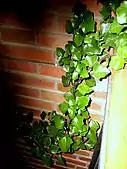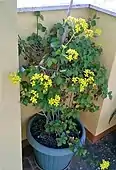Senecio angulatus
Senecio angulatus, also known as creeping groundsel[6] and sometimes as Cape ivy,[7] is a succulent plant from the family Asteraceae of the genus Senecio that is native to South Africa.[8] It is a scrambling[9] and a twining herb[10] that can become an aggressive weed once established, making it an invasive species in some countries.[4] However, it is grown as an ornamental plant for its satiny foliage and sweet-scented flowers.[11]
| Senecio angulatus | |
|---|---|
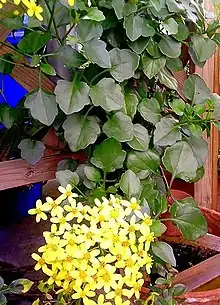 | |
| Scientific classification | |
| Kingdom: | Plantae |
| Clade: | Tracheophytes |
| Clade: | Angiosperms |
| Clade: | Eudicots |
| Clade: | Asterids |
| Order: | Asterales |
| Family: | Asteraceae |
| Genus: | Senecio |
| Species: | S. angulatus |
| Binomial name | |
| Senecio angulatus L.f. (1781) | |
 | |
| Native range of S. angulatus | |
| Synonyms | |
|
Senecio macropodus DC. | |
Senecio angulatus can be distinguished vegetatively from Delairea odorata by the lack of lobes at the leaf stalk base, the fleshy leaf surface and the outwardly curved leaf teeth.[4] Senecio tamoides has been misapplied in Australia and is currently considered to be Senecio angulatus.[12]
Description
Leaves and stems
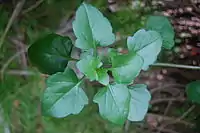
Its form is a dense tangled shrub 2 metres (6.6 ft) tall[13] or a climber that can reach 6 metres (20 ft) high, if suitable support is available.[10] The leaves are 3.7 centimetres (1.5 in) to 22 centimetres (8.7 in) long and 1 centimetre (0.39 in) to 14 centimetres (5.5 in) wide and occur in 1-4 pairs. They are thick, glossy, fleshy and coarsely toothed, with one to three teeth each side[4] and bluntly lobed,[13] with upper leaves becoming smaller with fewer teeth or none at all.[4] They have a frosted look from a powdery coating on the lower side.[5]
Leaf stalks are 1 centimetre (0.39 in) to 4 centimetres (1.6 in) long.[14] The leaves have stalks or stems which embrace the larger leaf surface which is not lobed, oval to triangularly shaped or very blunt to pointed at the tips and blunt to flat at the base. The leaves have a frosted look from a powdery coating on the lower side.[5]
The stems are succulent, pale green, and are often variegated with pale yellow green and purple. They are slightly angular[5] (not upright) and usually sparingly branched.[4] Neither stems nor leaves are hairy.[4][5][14]
Inflorescence
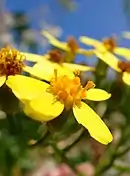
Senecio angulatus produces numerous flowers[5] in open clusters at the end of its branches or stems.[4] The strongly scented flowers are on an elongated stem that continue to open in succession from the base up as the stem continues to grow. The mass of clusters end more flat at the top than pyramid-like,[5] and are 4 centimetres (1.6 in) to 8 centimetres (3.1 in) in diameter.[14] Often the cluster droops with the flower heads at the end of the cluster turning upwards.[5]
Flower stalks are mostly hairless or with some short hairs, 6.5 millimetres (0.26 in) to 10.5 millimetres (0.41 in) long. Flower heads are attached to flower stalk by fine pointed 8-11 bracts 5 millimetres (0.20 in) to 6 millimetres (0.24 in)[4] which are surrounded by 4-7 pale green and sometimes purple tinged at the base supplementary bracts, 1.5 millimetres to 2.5 millimetres which make a cup shape around the base of the involucre.[5] Each stalk is capable of producing 10-15 disc florets.[14]
Flower-heads are radiate and urn-shaped.[14] Ray florets are nearly always absent.[5] When they occur, there is a yellow ligule. The corolla has a yellow disc[4] surrounded by 4–6 dull golden yellow disc florets 5.5 millimetres (0.22 in) to 9.5 millimetres (0.37 in) long with hairless tubes, a slight expansion below the middle and lobes 1.3 millimetres to 2 millimetres wide.[5] S. angulatus flower heads have rays[4] (that look like petals) that make it more daisy-like[13] unlike D. odorata which doesn't.[14]
It flowers from April to May in Southern Africa[10] and May to July in Australia and New Zealand.[14]
Fruits and reproduction
Creeping groundsel is easily dispersed by wind-blown seed, stem fragments, and dumped garden waste.[13] Achenes are 3 millimetres to 4 millimetres long,[4][5] ribbed or grooved with short hairs in the grooves[4][5] and a tapering cylindrical shape.[4][14] The parachute-like hairs, the pappus, are 5 millimetres to 7 millimetres long.[4][14]
Cultivation
The plant is predominantly cultivated in North Africa, the Mediterranean Basin and the Levant.[15][16] In Queensland, climbing groundsel may have increased in popularity following the Boer War, as there were anecdotal accounts that it was introduced from South Africa by the soldiers who returned to Australia after 1902. Moreover, it was displayed in garden pillars in Brisbane newspapers between 1906 and 1910, praising the plant for the beauty of both its foliage and its yellow clusters of blooms.[17]
The plant grows in USDA hardiness zones 9a through 11b and is medium to fast-growing. Very drought tolerant, it would flourish better with some water in the summer and would bloom more often in full sun. It can grow indoors as a houseplant, provided it gets some sunlight. Pruning is necessary as the plant can become limp when it gets taller. Pests include aphids.[18] Propagation can be done by cuttings (as the plant easily roots from the branch tips), and this is to be conducted between spring and fall (since it is somewhat winter dormant).[19][20] Seeds prefer consistent moisture and warm temperatures to germinate. Annual fertilisation is necessary, though not mandatory.
Distribution
It is native to the Cape Province in South Africa, but is naturalized in parts of South Italy, France, Portugal and some coastal areas in southeastern Australia.[2][14] It is invasive New Zealand and Victoria, Australia.[9][21] Because it is aggressive, it can smother the existing native vegetation both in the ground layer and canopy, thus altering the light climate in the invaded community and sometimes suppress the regeneration of native plants.[13]
Native:
- Afrotropic
- Southern Africa: South Africa (Cape Province)
Current
- Afrotropic
- East Tropical Africa: Uganda, Kenya, Tanzania
- Southern Africa: South Africa
- Australasia
- Australia: Western Australia (Esperance Plains, Warren, Swan Coastal Plain),[10] New South Wales (South Coast and Mid North Coast), southern Victoria and Tasmania.
- New Zealand: New Zealand North, New Zealand South (Nelson City, Wairau Bar (Marlborough), Banks Peninsula)
- Palearctic
- Northern Africa: Tunisia, Libya[22] and Algeria[23]
- Macaronesia: Canary Islands (Gran Canaria, Hierro, Tenerife), Balearic Islands (Ibiza, Formentera, Mallorca, Menorca)
- Southwestern Europe: Corsica, Channel Islands, Spain, France & Monaco, Portugal
- Southeastern Europe: Italy, Sardinia, Sicily, Albania, Croatia and surrounding islands[22]
Sources: GRIN,[3] ALUKA,[5] FBAF,[10] NSWF,[14] NZPND,[4] BGB[16]
Common names
- English: Creeping groundsel,[6] garden senecio, mile-a-minute, scrambling groundsel
- French: Séneçon anguleux[16] (senecio angular)
- Italian: senecio rampicante (creeping senecio)
- Spanish: la hiedra del Cabo, senecio hiedra (cape ivy, senecio ivy)
- Xhosa: inDindilili[7]
- Arabic: الشيخة القريض, الشيخة الزحف القريض, دعسة القطة (cat's footprint, climbing groundsel)
Gallery
 Flower stalk
Flower stalk Bunch of flowers
Bunch of flowers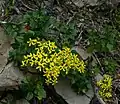 Cape Ivy trailing on ground rocks
Cape Ivy trailing on ground rocks Flowers closeup
Flowers closeup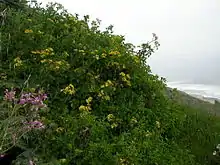 By the sea
By the sea Emerging flowers
Emerging flowers In a garden patio
In a garden patio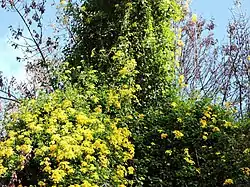 As a scrambling vine with profuse flowers
As a scrambling vine with profuse flowers Hanging from a rocky wall
Hanging from a rocky wall
References
- "Senecio angulatus". International Plant Names Index (IPNI). Royal Botanic Gardens, Kew. Retrieved 2008-05-29.
- "Senecio angulatus L.f. record n° 97995". African Flowering Plant Database. Archived from the original on 2013-01-16. Retrieved 2008-03-31.
- "Senecio angulatus". Germplasm Resources Information Network (GRIN). Agricultural Research Service (ARS), United States Department of Agriculture (USDA). Retrieved 2008-03-31.
- Landcare Research. "Senecio angulatus L.f. Suppl. 369 (1781)". Flora of New Zealand: Taxa. Landcare Research Allan Herbarium and New Zealand Plant Names Database. Retrieved 2008-04-01.
- "Senecio angulatus L.f." 2006-01-13. Retrieved 2008-03-31.
- Muyt, Adam (2001). Bush invaders of south-east Australia: a guide to the identification and control of environmental weeds in south-east Australia. R.G. and F.J. Richardson. pp. 304 pages. ISBN 0-9587439-7-5. Retrieved 2008-03-31.
- Quattrocchi, Umberto (2000). "Page 2456". CRC World Dictionary of Plant Names: Common Names, Scientific Names, Eponyms, Synonyms, and Etymology. CRC Press. ISBN 0-8493-2673-7. Retrieved 2008-04-14.
- "Senecio angulatus L.f." July 1931. Archived from the original on 2013-08-01. Retrieved 2008-03-31.
- "Cape ivy (Senecio angulatus)". Controlling problem weeds in riparian zones. Greater Wellington Regional Council. 2004. Archived from the original on October 15, 2008. Retrieved 2008-03-31.
- Western Australian Herbarium (2007-09-11). "Senecio angulatus L.f." FloraBase. Government of Western Australia. Retrieved 2008-03-31.
- La Concepción y sus doce embajadoras by La Opinión de Málaga
- Western Australian Herbarium (2007-09-11). "Senecio angulatus L.f." FloraBase. Government of Western Australia. Retrieved 2008-03-31.
- Tom Forney, Steve Hurst (2007). "Kudzu Pueraria lobata" (PDF). Government of Oregon. Retrieved 2008-03-31.
- National Herbarium of New South Wales. "Senecio angulatus L." New South Wales FloraOnline. Royal Botanic Gardens, Sydney. Retrieved 2008-03-31.
- "Parks where cultivated Senecio angulatus". Institut Botànic de Barcelona. Retrieved 2008-03-31.
- Botanic Garden and Botanical Museum Berlin-Dahlem. "Details for: Senecio angulatus". Euro+Med PlantBase. Freie Universität Berlin. Retrieved 2008-03-31.
- Climbing Groundsel (Senecio angulatus) by Weeds of Melbourne, July 10, 2019
- Climbing Groundsel (Senecio angulatus) by Weeds of Melbourne, July 10, 2019
- Senecio angulatus (Climbing Groundsel) by World of Succulents, August 30, 2013
- Creeping or climbing groundsel (Senecio angulatus) by Eurobodalla Shire Council
- Weeds of Australia (Biosecurity Queensland Edition). "Senecio angulatus L. f." Queensland Government. Retrieved 2020-02-08.
- Senecio angulatus (Creeping Groundsel) MaltaWildPlants.com by Stephen Mifsud
- Apparition de Senecio angulatus (Asteraceae) en Algérie by M. D. Miara, L. Boutabia, S. Telaïlia & E. Vela, 3 September 2018. Retrieved 4 May 2020
External links
 Media related to Senecio angulatus at Wikimedia Commons
Media related to Senecio angulatus at Wikimedia Commons Data related to Senecio angulatus at Wikispecies
Data related to Senecio angulatus at Wikispecies- Senecio angulatus in the CalPhotos Photo Database, University of California, Berkeley
- "Herbarium record". Neotropical Herbarium Specimens. fieldmuseum.org. Retrieved 2008-04-22.

